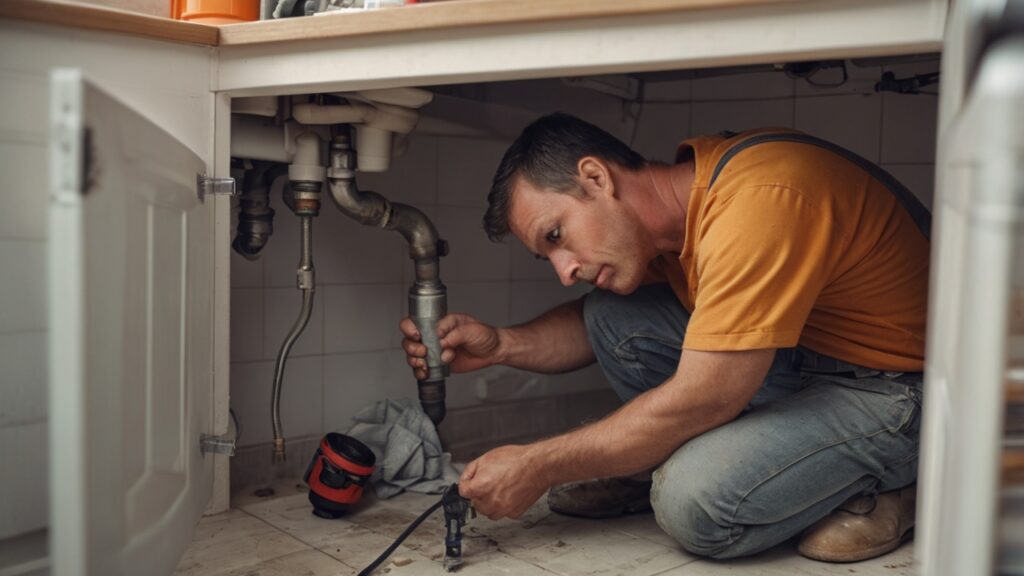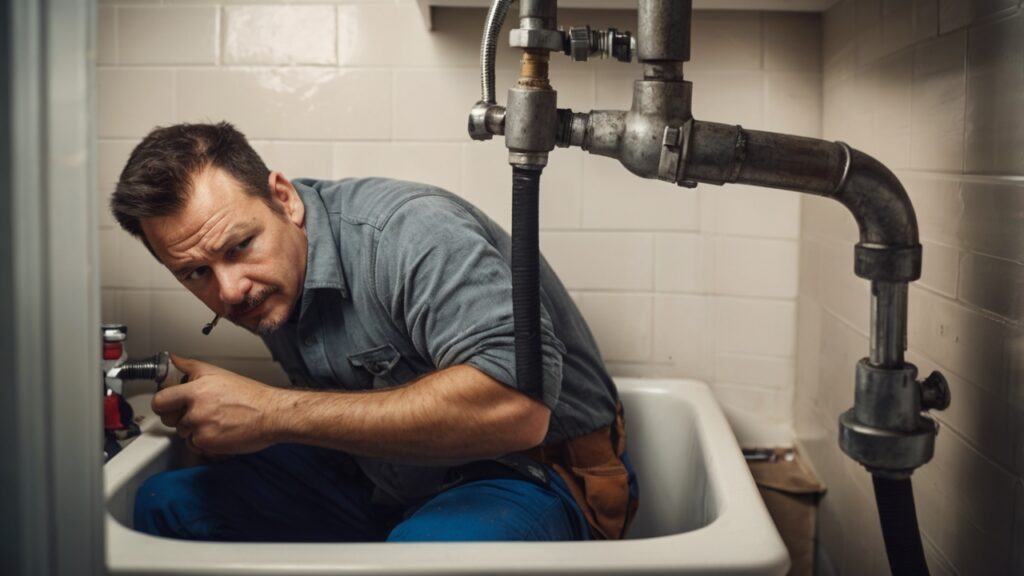There’s a very specific kind of panic that sets in the moment water starts spraying across your living room wall or flooding the basement. A burst pipe can feel like the worst-case scenario for any homeowner. Not only is there the shock of seeing water damage in real time, but also the confusion about what to do when a pipe bursts right in front of your eyes.
I’ve been in that exact position before. Water gushed from a copper line in my laundry area, soaking the floor within minutes. The first steps for a plumbing emergency don’t always come naturally under pressure—it’s easy to freeze. And honestly, it was only after learning how to shut off your main water valve that I felt even remotely prepared for another round.
This guide isn’t a neat encyclopedia. It’s messy, like real life. I’ll walk you through Your Step-by-Step Guide to Responding to a Burst Pipe, sprinkling in lessons learned, advice from professional plumbers, and a few mistakes I made that you can avoid.
Before we dive in, if you’re in North Carolina and just want help now, I strongly suggest checking out this resource: Recommended Plumbing Companies in North Carolina. Having a reliable list of experts ready to call could save you thousands in damages.
Step 1: Shut Off the Main Water Supply
This sounds obvious, but many homeowners don’t even know where their main valve is located. I didn’t until I was ankle-deep in water.
- Look near your water meter (inside the basement, crawl space, or on an exterior wall).
- Turn the valve clockwise until it stops—most are gate valves or ball valves.
Knowing how to shut off your main water valve can literally make the difference between a soaked carpet and a destroyed foundation.
A trusted expert from Raleigh once told me, “Every second counts. The best homeowners I meet are the ones who already know how to shut their water off before I arrive.”
Step 2: Drain the System
Once the water is off, you’re not done. There’s still water trapped inside the pipes. Open all the faucets in your home—sinks, tubs, outside spigots. Flush every toilet. This relieves pressure and stops further leaking.
I once forgot this step and left water sitting in the damaged pipe. By the time the plumber came, my drywall was twice as ruined as it should’ve been.
Step 3: Kill the Power if Needed
If water is spreading toward electrical outlets, don’t risk it. Go to your breaker box and shut off the electricity in the affected area. Safety first.
Step 4: Mitigate Immediate Damage
Grab every towel, mop, and bucket you own. If you’ve got a wet/dry shop vacuum, even better. Move furniture, electronics, and valuables out of the water’s path.
This is where the saying “small leaks – big problems” becomes too real. I’ve seen a tiny drip soak into hardwood floors, then turn into warped boards that cost thousands to replace.
Step 5: Call a Professional Immediately
Here’s the thing: DIY Plumbing vs. Hiring a Pro is a debate that often comes up, but a burst pipe is not the time to play handyman.
- Professionals bring specialized tools like pipe cutters, soldering kits, PEX expanders, and industrial-grade epoxy.
- They can also identify if the burst was caused by frozen pipes, corrosion, high water pressure, or faulty installation.
A plumber in Durham once shared, “The repair itself can take less than an hour if done right. But half my job is undoing the bad DIY patches homeowners try first.”
If you’re in North Carolina, bookmark this trusted resource for the best help: Pro Service Tips.
Preventing Frozen Pipes and Bursts
Prevention is a huge part of protecting your home. Winter storms hit hard, and frozen pipes are the most common reason for bursts.
Tips I personally use:
- Keep cabinet doors open under sinks during freezing nights.
- Wrap exposed pipes with foam insulation sleeves.
- Let faucets drip slightly to keep water moving.
It feels silly leaving a faucet running, but compared to the thousands in water damage, it’s a no-brainer.
Specialized Plumbing Services Every Homeowner Should Know
Responding to a burst pipe is urgent, but sometimes it exposes other hidden issues. These are services I’ve had to call for after my own emergencies:
- Slab leak detection (often invisible until you see cracks in flooring).
- Sewer line camera inspections (roots can sneak in and cause backups).
- Water heater relief valve replacements (a small leak here is dangerous).
- Whole-house repiping (especially in older homes with galvanized steel).
These aren’t things you want to gamble on. Having specialized plumbing services every homeowner should know in your back pocket makes you a more prepared homeowner.
Repair Processes and Tools Explained
Since this isn’t meant to be a dry manual, let’s talk through what plumbers actually do when they arrive:
- Copper Pipe Repair – The damaged section is cut out, cleaned with sandpaper, and replaced using soldering and a blowtorch.
- PEX Pipe Repair – PEX tubing is flexible, so plumbers use crimp rings and expansion tools to replace sections quickly.
- PVC Pipe Repair – They’ll cut the damaged pipe, clean the ends, and glue new fittings with solvent cement.
Spare parts are relatively inexpensive, but the expertise is what you’re paying for. As one expert said, “You’re not just buying pipe. You’re buying peace of mind.”
Real-Life Case Study
One of my neighbors, a young couple in Chapel Hill, had their upstairs bathroom pipe burst while they were at work. By the time they got home, the ceiling in their living room had collapsed from water weight. They called a reliable plumber right away, who not only replaced the pipe but also helped document damages for insurance.
The lesson? Calling quickly is everything. Had they known earlier steps like draining faucets, the destruction might have been half as bad.
Who to Call for a Burst Pipe
This is where preparation pays off. Don’t wait until the floor is flooding. Save numbers of trusted, reliable, and professional experts now.
For readers in North Carolina, again, here’s the recommended list: 5 Recommended Plumbing Companies in North Carolina.
For those elsewhere, look up reviews, ask neighbors, and see our upcoming guide on How to Find a Reliable Plumber.
Additional Future Blog Ideas
For future readers who want more:
- Early signs of water hammer damage
- How to test water pressure at home
- Mold prevention after water leaks
- Choosing between copper, PEX, or CPVC piping
- Emergency shut-off devices and smart water alarms
FAQs
Q1: How do I know if a pipe is about to burst?
Look for bulges, frost on pipes, banging noises (water hammer), or recurring leaks. These are warning signs.
Q2: Can I patch a burst pipe myself?
Temporary patches exist—like epoxy putty or rubber sleeves—but they’re short-lived. Professionals are the only safe long-term fix.
Q3: Will insurance cover a burst pipe?
Most policies cover sudden, accidental damage (like a burst). They usually don’t cover damage from neglect or slow leaks. Always check your policy.
Final Thoughts
A burst pipe is stressful, no doubt about it. But with preparation—knowing the first steps for a plumbing emergency, practicing how to shut off your main water valve, and having a reliable plumber’s number saved—you’re already ahead of most homeowners.
Remember the simple truth: small leaks become big problems fast. Take action early, lean on professionals, and don’t be afraid to ask for help.
If this article helped you, please hit the share buttons below and pass it along. You never know who in your neighborhood might need it tonight.


